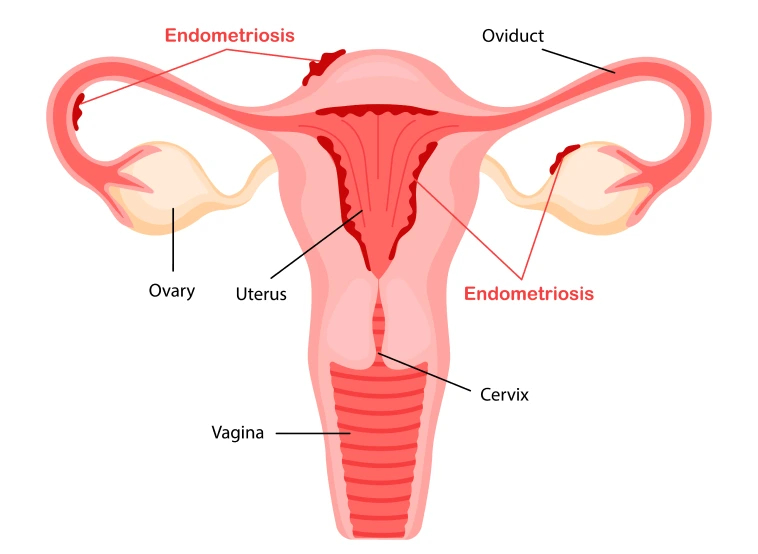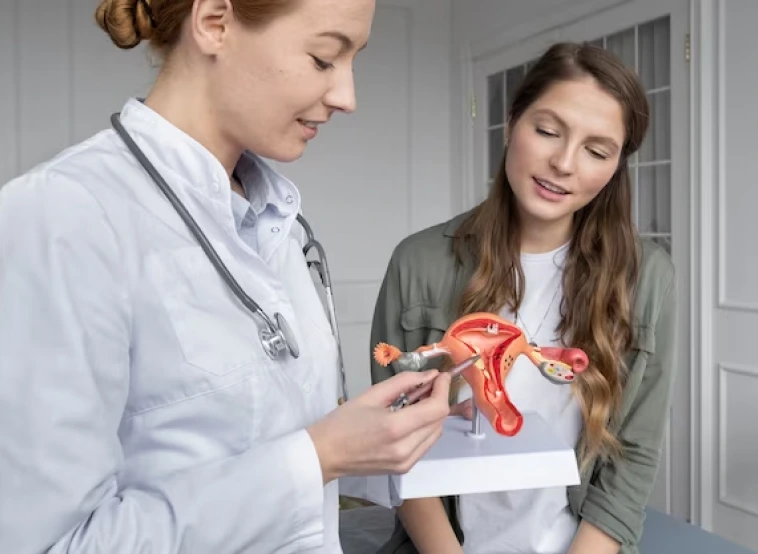Severe Endometriosis Treatment in Abu Dhabi
Endometriosis affects approximately 1 in 10 females, while it is rare in males. Often its symptoms are ignored as “bad cramps,” which leads to an almost 10-year delay in diagnosis.
From causing excruciating period cramps to infertility or subfertility, endometriosis may take a huge toll on women’s physical and mental health. However, the latest endometriosis treatment in Abu Dhabi is very effective in coping with the disease. Read on to learn all about endometriosis and its management from our endometriosis specialist in Abu Dhabi, Dr. Monica Chauhan.
What does Endometriosis Mean?
Endometriosis is a condition where tissues similar to the uterus lining endometrium grow on or outside the uterus, on other nearby organs. These tissues can grow within your abdomen, pelvis, or even chest. These tissues differ in structure and behavior from the normal endometrium that is shed during menstruation. The presence of endometriosis tissue can lead to inflammation, invasion of these tissues surrounding organs, and the formation of scar tissue, which can cause pain, infertility, and dysfunction of affected organs.

What does Endometriosis Mean?
Endometriosis lesions are classified into three major groups: superficial peritoneal lesions, cystic lesions on ovaries, and deep subperitoneal lesions.
Superficial peritoneal lesions
Superficial peritoneal lesions are the most frequent and are located in the peritoneum. They are small, superficial lesions with a depth of infiltration that does not exceed 5 mm. These lesions can have different appearances, such as active, red lesions, or brownish or black microcysts indicating an old hemorrhage, while some are whitish, probably with scarring, attesting to a healing process.
Cystic lesions on ovaries
Cystic lesions on ovaries, also known as ovarian endometriomas, are hemorrhagic lesions that form under the ovarian parenchyma and later on progressively displace it. These lesions vary in size from a few millimeters to several centimeters. The lesion constantly penetrates the intra-ovarian surface of the ovary, like a caterpillar penetrates an apple.
Deep subperitoneal Lesions
These infiltrate greater than 5 mm and are hard, fibrous lesions in which the hormone-dependent endometrial tissue. These lesions have a tendency to infiltrate the surrounding organs, behaving aggressively, much like tumors, leading to the appearance of severe forms, the removal of which is increasingly difficult.
Ovarian endometriomas are present in 25-50% of women with endometriosis. A deep lesion is seen in around 20% of women with endometriosis. Approximately 15% of women with digestive endometriosis have lesions on the diaphragm.
What does Endometriosis Mean?
Adenomyosis refers to a condition in which the endometrium (lining of the uterus) is present within the muscular layer of the uterus (myometrium). While sometimes referred to as “internal endometriosis,” adenomyosis is a distinct condition that occurs solely within the uterus.
In women over 40, adenomyosis may be considered a natural aging process of the uterus, but in younger women, it can be considered a pathology when it occurs alongside endometriosis and is accompanied by painful symptoms or heavy bleeding during or between periods.
Symptoms of adenomyosis may be similar to those of endometriosis and may include:
- Painful menstrual periods (dysmenorrhea)
- Pain during sexual intercourse (deep dyspareunia)
- Pain between periods (intermenstrual pain)
- Heavy menstrual bleeding (menorrhagia)
- Bleeding between periods (metrorrhagia)
Adenomyosis is often associated with uterine fibroids, which can also cause pelvic pain and bleeding.
What are the Signs and Symptoms of Endometriosis?
- Fatigue
- Low back and/or leg pain
- Painful bowel movements
- Severe menstrual cramps
- Pain during sexual intercourse
- Pelvic or abdominal pain that is not related to menstruation
- Gastrointestinal issues such as nausea, bloating, diarrhea, and constipation
- Less common symptoms include breathing or shoulder pain, which may indicate the presence of endometriosis in the diaphragm or lungs
- In rare cases, individuals with lung endometriosis may experience coughing up blood or the collapse of a lung during their menstrual period

What are the Potential Causes of Endometriosis?
There are several theories about what causes endometriosis, but it is most likely a combination of genetic, environmental, and embryonic factors. While the commonly taught theory is that endometriosis is caused by the backflow of menstrual blood, “reflux menstruation,” and treatments are offered for the condition.
Often, individuals with endometriosis have other conditions that need to be addressed, including pelvic floor muscle pain, adenomyosis, and interstitial cystitis/bladder pain syndrome, among others.
Diagnosis of Endometriosis
The gold standard for diagnosing endometriosis is a biopsy, which involves removing suspicious tissue during surgery and having a pathologist specialized in this area examine the tissue under a microscope.
However, the initial diagnosis may include:
Patient’s medical history
Blood and hormone tests
Abdominal, vaginal, and rectal examination
Vaginal and pelvic ultrasounds
CT scans
Laparoscopy
Note: Endometrial tissues are very sensitive to the hormonal response of the body and may inflame during menstruation.

Endometriosis Treatment in Abu Dhabi
Endometriosis can cause severe pain, cramps, and other symptoms, and treatment is essential to manage the disease.
The treatment for endometriosis depends on the severity of symptoms, health conditions, and pregnancy preference.
Medicinal management of endometriosis
Painkillers are often used as a first-line treatment for mild to moderate endometriosis pain. Drugs like pan rebel can help alleviate pain, but long-term use can have side effects. Therefore, they should be used under the guidance of a doctor.
Progestin is another treatment option for endometriosis, which can temporarily relieve symptoms. It has fewer side effects than GnRH, another treatment option. However, progestin does not stop the progression of the disease and does not treat endometriosis. Symptoms return once the treatment is stopped.
Combined birth control pills (BCP) and GnRH agonists are other options to manage endometriosis symptoms. They can temporarily relieve severe symptoms, but there are side effects associated with them. However, they do not stop the progression of the disease, and symptoms can return once the treatment is stopped.
Surgical treatments for endometriosis
Endometriosis can be treated with both medical and surgical methods. While medical treatment methods involve the use of painkillers, progestin, combined birth control pills (BCP), and gonadotropin-releasing hormone (GnRH), surgical treatment methods involve ablation, excision, hysterectomy, and oophorectomy.
Ablation is a surgical method that provides short-term relief from symptoms but leaves the disease behind, leading to a higher recurrence rate. Also, there is no diagnosis involved in this method.
Excision provides long-term relief from symptoms, improves fertility, and can even be curative in some cases. This method removes all endometriosis tissues and provides a clear diagnosis, leading to a low recurrence rate.
Hysterectomy is a surgical method that does not treat endometriosis or stop its progression. However, it is useful in treating adenomyosis, a condition where the endometrial tissue grows into the uterine wall.
Oophorectomy, or the removal of ovaries, is not a treatment for endometriosis as the disease produces its own estrogen and can progress even without the ovaries. However, it might provide some pain relief.